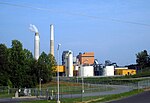Sauratown Township, Stokes County, North Carolina
Piedmont Triad region, North Carolina geography stubsTownships in North CarolinaTownships in Stokes County, North CarolinaUse mdy dates from July 2023

Sauratown Township is one of nine townships in Stokes County, North Carolina, United States. The township had a population of 5,560 according to the 2000 census. Geographically, Sauratown Township occupies 46.35 square miles (120.0 km2) in central Stokes County. The township's southern border is with Forsyth County and the eastern border is with Rockingham County. The only incorporated municipality within Sauratown Township is Walnut Cove. There are also several unincorporated communities located here.
Excerpt from the Wikipedia article Sauratown Township, Stokes County, North Carolina (License: CC BY-SA 3.0, Authors, Images).Sauratown Township, Stokes County, North Carolina
Geographical coordinates (GPS) Address Nearby Places Show on map
Geographical coordinates (GPS)
| Latitude | Longitude |
|---|---|
| N 36.2962698 ° | E -80.109357 ° |
Address
Belews Creek Junction
27042
North Carolina, United States
Open on Google Maps







